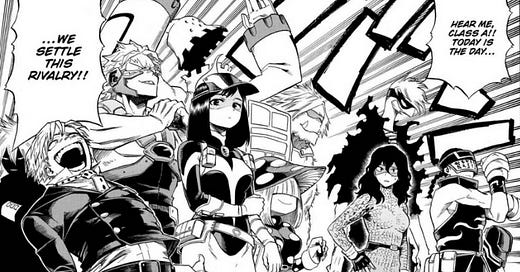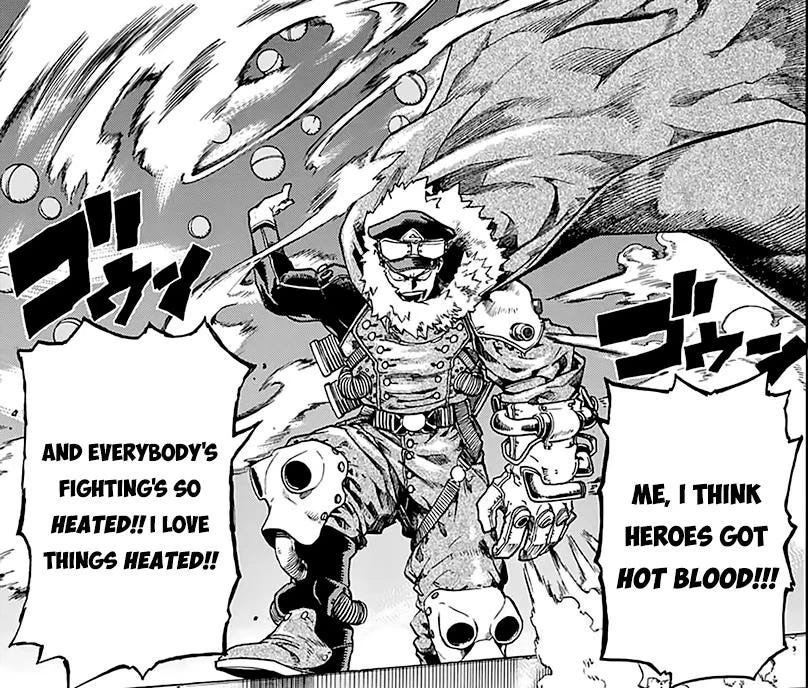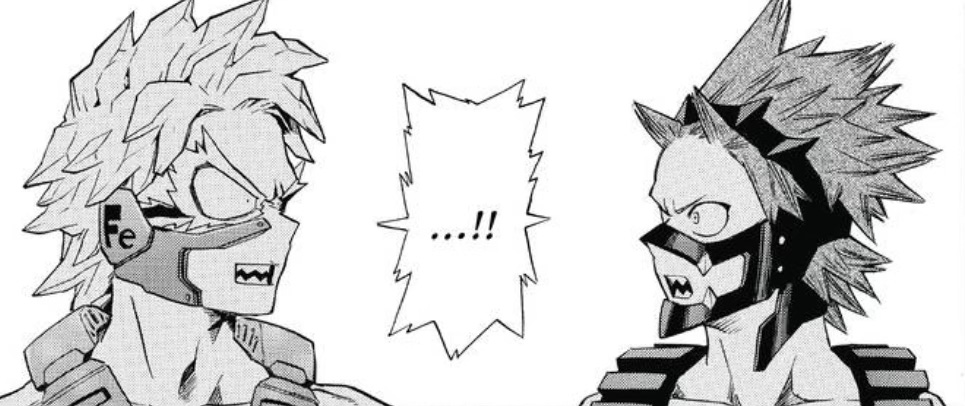Preface
For anyone new to my relationship with My Hero Academia, here’s the short version of what you need to know—my wife isn’t really into manga/anime, but she adores Midoriya, who she calls Roy. I’ve only ever written about Roy once, and yes, I do call him Roy all the time, for her sake.
She keeps asking why I don’t write about Roy more, so to find inspiration, I picked up this My Hero Academia: Ultra Analysis book because it has a conversation between Tohei Horikoshi and Tite Kubo (Bleach).
It’s like a Pokédex of characters and it became pretty apparent what I’d stumbled into, and it’s something I actually find really inspirational in My Hero Academia. It’s like, I never actively think about the craft elements in My Hero Academia, but every time I find one, I can’t help but remark how well it’s executed.
And thanks to this Ultra Analysis book, it’s easier to see why.
Preface over!
Have I mentioned recently that character is everything? By recently, I mean in the past 24 hours? Probably. But still. Character is everything. Everything. Not just your hero, but everyone around your hero, everyone who crosses paths with your hero, everyone your hero has to beat up.
The simple fact is that if you want your characters to be believable, to be favorited by readers, they can’t just be characters in a book, they have to be complete human beings. There was old logic that you could have flat characters, characters who enter the story, play one specific role, and then exit. And sure, you can do that.
But what happens when a character, even the one with one line, slouches a little, carries a permanent smirk and keeps checking his phone? Suddenly we have questions about him, good questions. You never have to answer them either. You can just let your readers wonder away.
Enter My Hero Academia. Perhaps the biggest cast in all of shonen manga, hell maybe in all of storytelling, and every single one of them has a distinct personality.
Before we get into My Hero Academia, here’s what you need to know:
80% of the world has quirks, or special skills, that range from super strength to having a turtle-like shell. In this world, there are schools that train young Quirk-wielders how to use their special skills, and chief among these schools is UA High School, where Midoriya—sorry honey, Roy—learns alongside gobs of other young Quirk-users to better the world around them.
And that’s all you need to know.
Everything that Horikoshi says ties back to character. His design, his writing, his character creation, it all ties back into creating a complete character every single time. Which makes sense given how incredible his character development is. How each character has layers, has family, has wants and needs and dark corners that we’d love to see into.
Except Roy of course. Roy is perfect. (That was for my wife.)
Even smaller characters that we don’t see often, like Gale Force or Gran Torino, have so many layers attached to them. Things we want to know. And that’s the thing, right? Even if you give a character one demonstrative trait, like Gale Force being hyper competitive. Suddenly there are things we can read into—what made him that way, why does he embrace it so wholly, what is his home life like? All things we may never get answers to, but in minimal page time, he’s still fascinating. He’s not flat at all.
Not only does Horikoshi absolutely crush the whole concept of eliminating flat characters, but he even goes out of his way when there are redundancies to poke fun at it. For this, let’s zoom in on Kirishima (Red Riot) and Tetsutetsu Tetsutetsu (Steel).
I hyper fixate on these two because not only is their quirk redundant, but Horikoshi seems to take that fact and make a meal of it by making Steel’s actual name as redundant as a name can possibly be. Almost like him poking fun, saying “this is what it looks like when characters are too similar.”
My Hero Academia does not do similarity overlaps. Even when character’s align morally, like Endeavor and All Might, they still butt heads over personal ambition, policy and personality. Same goes with Roy and Bakugo. This was the subject of my last post about My Hero Academia, analyzing the character contrasts throughout literally every relationship in the series.
As a comparison, let’s look at Harry Potter. Specifically, the house sorting system at Hogwarts. There are a lot of characters at Hogwarts, but by sorting them into one of four houses, they inherently take on certain traits, as their house dictates. And while there are little bits of individuality, like Seamus always blowing himself up and Neville being clumsy, that hardly separates the inner ranks of Gryffindor the way that My Hero Academia separates so many of the students within Class 1-A.
Now, to be fair, Harry Potter does that to help us fast track our understanding of characters. What do we actually know of Cedric Diggory? Well, he’s a team player, kind and resourceful by default because that’s the Hufflepuff way. He’s also dead.
Without that pre-sorting feature though, if these students were just at school, it would take a much longer time to get to know characters like, I don't know, Justin Finch-Fletchley. You remember him? I don’t, I just picked a random student. But by being a Hufflepuff, we can make assumptions about his character.
In My Hero Academia, you can’t bypass via assumptions, so to counter that, Horikoshi—and all creators, for that matter—have to compensate by being demonstrative in their character traits. Now, I touched on this with Dandadan as a focus, keying in on character first impressions, but this is different than that. It’s first impressions and everything that comes after.
Take Mina Ashido, for instance, a member of Class 1-A. Her quirk, Acid, is pretty self-explanatory. While she isn’t a major player, even being in the main class, her personality is very recognizable and consistent. Her high-energy, easy-going, courage, her understanding of her quirk, her resourcefulness when faced with conflict. She has so many personality traits specific to her.
That becomes even easier with the Quirk mechanics within the My Hero Academia universe, but it all serves the same purpose—original characters, all with their own personalities.
Not to regurgitate what I said in my other piece on My Hero Academia, but I do want to touch on it here. By having these well-defined characters, it doesn’t just serve the individual character, but the cast around them. My other piece was all about contrasts, how strong personalities like Roy’s and Bakugo’s mold and change when they interact. How friendship feels more real, how enemies feel more threatening, all because personalities. All because of character chemistry.
It’s mad science, truly. I always hate thinking this deeply when I myself am creating because it’s… well, it’s not fun. It’s labor intensive. But it serves you so well when looking back on what you’ve done, or looking for opportunities to build out characters who are flirting with being flat.







